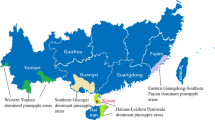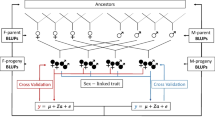Abstract
Larix gmelinii var. principis-rupprechtii (Mayr.) Pilger is an important native tree species in North China with advantages of fast growth, straight trunk, and good wood properties. The multi-year and multi-site breeding research of families of the species has not been reported previously. Based on diameter at breast height (DBH), height and volume of 25 families on four experimental sites, we calculated variance components, genetic parameters, juvenile and mature trait correlations and made genotype main effect plus genotype × environment interaction effect (GGE) biplot based on the breeding values estimated using the method of best linear unbiased prediction (BLUP). Compared with height, DBH and volume had higher heritability and larger variation coefficients, making them the more suitable traits for family selection and evaluation. Based on these, GGE biplots containing 20 combinations of site × age were drawn using data at 13 to 17 years when the interactions between family and location were strong. Test sites classifications based on DBH, and volume were inconsistent, with two categories for DBH and one for volume. The Guyuan site was the most suitable with strong discriminating ability, high representativeness and stability among tree ages. Integrating the ranking results of DBH and volume, families 66, 76, 82 and 111 were high-yielding and stable, families 78 and 96 were high-yielding with above average stability, families 72 and 79 were high-yielding with below average stability, whereas stability of family 100 was inconsistent between DBH and volume. Early selection based on DBH was convenient and reliable, and can be made at seven years. This study provides support for the selection of Larix gmelinii var. principis-rupprechtii families in Hebei province and an example for the application of stem analysis data from multiple sites in tree breeding.







Similar content being viewed by others
References
Badu-Apraku B, Akinwale RO, Obeng-antwi K, Haruna A, Kanton R, Usman I, Ado SG, Coulibaly N, Yallou GC, Oyekunle M (2013) Assessing the representativeness and repeatability of testing sites for drought-tolerant maize in West Africa. Can J Plant Sci 93(4):699–714
Bai TD, Xu LA, Wang ZR, Lin NQ, Zhang SH (2012) Estimation of parents’ genetic gain by open-pollinated progeny test of seedling seed orchard of Masson pine. Forest Res 25(4):449–455 (in Chinese)
Balocchi CE, Bridgwater FE, Zobel BJ, Jahromi S (1993) Age trends in genetic parameters for tree height in a nonselected population of loblolly pine. For Sci 39(2):231–251
Bian LM, Shi JS, Zheng RH, Chen JH, Wu HX (2014) Genetic parameters and genotype-environment interactions of Chinese fir (Cunninghamia lanceolata) in Fujian Province. Can J for Res 44(6):582–592
Carreras R, Bessega C, López CR, Saidman BO, Vilardi JC (2017) Developing a breeding strategy for multiple trait selection in Prosopis alba Griseb., a native forest species of the Chaco Region in Argentina. Forestry 90(2):199–210.
Dia M, Wehner TC, Hassell R, Price DS, Boyhan GE, Olson S, King S, Davis AR, Tolla GE (2016) Genotype × environment interaction and stability analysis for watermelon fruit yield in the United States. Crop Sci 56(4):1645–1661
Diao S, Hou YM, Xie YH, Sun XM (2016) Age trends of genetic parameters, early selection and family by site interactions for growth traits in Larix kaempferi open-pollinated families. BMC Genet. https://doi.org/10.1186/s12863-016-0400-7
Gilmour AR, Gogel R, Cullis BR, Thompson RJ (2016) ASReml user guide release 4.0. Vsn International Ltd, Hemel Hempstead, UK.
Kivuva BM, Githiri SM, Yencho GC, Yencho GC, Julia S (2014) Genotype × environment interaction for storage root yield in sweet potato under managed drought stress conditions. J Agric Sci 6(10):41–56
Lai M, Sun X, Chen D, Xie Y, Zhang S (2014) Age-related trends in genetic parameters for Larix kaempferi and their implications for early selection. BMC Genet. https://doi.org/10.1186/1471-2156-15-S1-S10
Lai M, Dong LM, Yi M, Sun S, Zhang Y, Fu L, Xu Z, Lei L, Leng C, Zhang L (2017) Genetic variation, heritability and genotype × environment interactions of resin yield, growth traits and morphologic traits for Pinus elliottii at three progeny trials. Forests. https://doi.org/10.3390/f8110409
Laurie SM, Booyse M (2015) Employing the GGE SREG model plus Elston index values for multiple trait selection in sweetpotato. Euphytica 204(2):433–442
Laurie SM, Booyse M, Labuschagne MT, Greyling MM (2015) Multi-environment performance of new orange-fleshed sweet potato cultivars in South Africa. Crop Sci 55(4):1585–1595
Li QF, Ma JW, Wang JH, Wang YN, Pan CL (2015) Analysis of stage test and height selection of open-pollinated Pinus tabulaeformis family. Forest Res 28(4):451–456 (in Chinese)
Lin YZ (2019) Research methodologies for genotype by environment interactions in forest trees and their applications. Sci Silvae Sin 55(5):142–151
Lin YZ, Yang HX, Ivković M, Gapare WJ, Colin Matheson A, Wu HX (2013) Effect of genotype by spacing interaction on radiata pine genetic parameters for height and diameter growth. For Ecol Manag. https://doi.org/10.1016/j.foreco.2013.05.015
Ling J, Xiao Y, Hu J, Wang F, Zhang H (2021) Genotype by environment interaction analysis of growth of Picea koraiensis families at different sites using BLUP-GGE. New for 52(1):113–127
Ma CG, Zhou TX, Xu JL (2000) A preliminary study on genetic control of growth traits and early selection of Chinese fir (Cunninghamia Lanceolata Hook) clones. Sci Silvae Sin 36(Z1):63–69 (in Chinese)
Miao XF, Zhang HG, Hou D, Sun YH, Hao JF, Xu KY (2018) Genetic variation and stability of families in multiple sites of hybrid larch. J Northeast for Univ 46(12):1–8 (in Chinese)
Naranjo SS, Moya R, Chauhan S (2012) Early genetic evaluation of morphology and some wood properties of Tectona grandis L. clones. Silvae Genet. https://www.researchgate.net/publication/263655827
Pan YY, Liang DX, Guo J, Fang W, Wang F, Li S, Zhao X (2018) Variance analyses on growth traits of Larix kaempferi in different seed sources. J Beijing for Univ 40(11):19–27 (in Chinese)
Ren HD, Yao XH, Kang WL, Li S, Wang KL, Duan FW (2010) Genetic variation and early selection of provenances and families of Acacia mearnsii. Sci Silvae Sin 46(3):153–160 (in Chinese)
Sun XM, Zhang SG, Hou YM, Li SY (2004) Age trends of genetic parameters for growth traits in short rotation Larix kaempferi families. Sci Silvae Sin 40(6):68–74 (in Chinese)
Weng YH, Tosh KJ, Park YS, Fullarton MS (2007) Age-related trends in genetic parameters for jack pine and their implications for early selection. Silvae Genet 56(5):242–252
Wricke G (1962) A method for measuring ecological range in field tests. Z Pflanzenzücht 47:92–96 ((in German))
Wu HX, Powell MB, Yang L, Ivkovi M, Mcrae TA (2007) Efficiency of early selection for rotation-aged wood quality traits in radiata pine. Ann for Sci. https://doi.org/10.1051/forest:2006082
Wu HB, Duan AG, Zhang JG (2019) Growth variation and selection effect of Cunninghamia lanceolata provenances at different stand ages. Sci Silvae Sin 55(10):181–192 (in Chinese)
Xing XD, Wang L, Bing XU, Yuan DS, Wang CH, Liu ZL, Yang JM, Zhang GJ (2019) Half-sib progeny test of Larix principis-rupprechtii plus tree. J Northwest for Univ 34(02):135–139 (in Chinese)
Xu NY, Li J (2015) Principles and applications of information ratio adjustment of GGE biplot-A case study of cotton mega-environment investigation in the Yangtze River Valley. Chin J Eco-Agric 23(9):1169–1177 (in Chinese)
Yan WK (2010) Optimal use of biplots in analysis of multi-location variety test data. Acta Agron Sin 36(11):1805–1819 (in Chinese)
Yang XY, Zhang SG, Sun XM, Song CW, Chen BR, Hou YM (2010) Genetic test of open-pollinated Larix kaempferi families and selection for the second- generation elite trees in northern sub-tropical alpine area. Sci Silvae Sin 46(8):45–50 (in Chinese)
Yin MY, Guo JJ, Wang CS, Zhao ZG, Zheng J (2019) Genetic parameter estimates and genotype×environment interactions of growth and quality traits for Betula alnoides Buch.-Ham. ex D. Don in four provenance-family trials in southern China. Forests. https://doi.org/10.3390/f10111036
Zhang HG, Li X, Zhou X (1996) Early-late correlation and early selection of the growth and wood traits of Larix Olgensis. J Northeast for Univ 24(5):12–18 (in Chinese)
Zhang Q, Zeng LH, He BX, Lian HM, Cai YL (2013) Age changes and genetic analysis of the resin-yielding capacity of open-pollinated families of masson pine. Sci Silvae Sin 49(1):48–52 (in Chinese)
Zhang SN, Luan QF, Jiang JM (2017) Genetic variation analysis for growth and wood properties of slash pine based on the non-destructive testing technologies. Sci Silvae Sin 53(6):30–36 (in Chinese)
Zhang H, Zhang YH, Zhang DW, Dong LH (2020) Progeny performance and selection of superior trees within families in Larix olgensis. Euphytica. https://doi.org/10.1007/s10681-020-02596-9
Zheng CH, Zhang HJ, Wang YZ, Dai JF, Dang L, Du ZC, Liu JT, Gao YR (2019) An analysis of a regional trial of Larix principis-rupprechtii families based on BLUP and GGE Biplot. Sci Silvae Sin 55(8):73–83 (in Chinese)
Acknowledgements
We are grateful to Drs. Yongchao Miao and Jingyao Chi for data measurements.
Author information
Authors and Affiliations
Corresponding author
Additional information
Publisher's Note
Springer Nature remains neutral with regard to jurisdictional claims in published maps and institutional affiliations.
Project funding: This work was supported by the Key Research and Development Program of Hebei Province [20326333D], Science and Technology Promotion Demonstration Project of forestry and grassland in Hebei Province [Hebei TG[2019]001], and Science and Technology Promotion Demon-stration Project of forestry and grassland in Hebei Province [Hebei TG[2020]013].
The online version is available at http://www.springerlink.com.
Corresponding editor: Yu Lei.
Rights and permissions
Springer Nature or its licensor (e.g. a society or other partner) holds exclusive rights to this article under a publishing agreement with the author(s) or other rightsholder(s); author self-archiving of the accepted manuscript version of this article is solely governed by the terms of such publishing agreement and applicable law.
About this article
Cite this article
Zheng, C., Dai, J., Zhang, H. et al. Family selection and evaluation of Larix gmelinii var. principis-rupprechtii (Mayr.) Pilger based on stem analysis data at multiple sites. J. For. Res. 34, 1627–1638 (2023). https://doi.org/10.1007/s11676-022-01589-9
Received:
Accepted:
Published:
Issue Date:
DOI: https://doi.org/10.1007/s11676-022-01589-9




